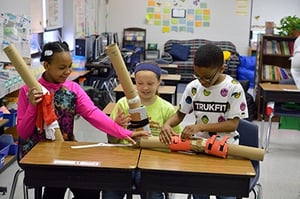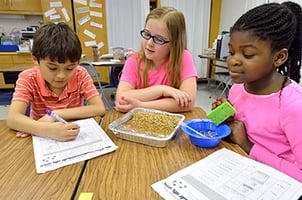 We’ve told you about how EiE meets the needs of many student populations, like English Learners and students with diverse needs, but there’s one population benefitting from EiE that may surprise you: students in gifted and talented (GT) programs. This week at the National Association for Gifted Children’s 2016 conference, EiE’s Chris San Antonio-Tunis presented his preliminary research about EiE’s impact on GT populations to a standing-room-only crowd. He shared a few reasons why real teachers from around the country love using EiE in their gifted and talented classrooms.
We’ve told you about how EiE meets the needs of many student populations, like English Learners and students with diverse needs, but there’s one population benefitting from EiE that may surprise you: students in gifted and talented (GT) programs. This week at the National Association for Gifted Children’s 2016 conference, EiE’s Chris San Antonio-Tunis presented his preliminary research about EiE’s impact on GT populations to a standing-room-only crowd. He shared a few reasons why real teachers from around the country love using EiE in their gifted and talented classrooms.
Failure is Destigmatized
At EiE, we consider learning from failure to be an engineering habit of mind. Working engineers often test their designs until they fail, because it helps them to improve their technologies and understand their limits. As you can see in the Snippet below, EiE engineers are fearless about failure. Gifted and talented teachers appreciate the opportunities that engineering provides to experience and discuss failure, because GT students often have less experience dealing with failure than their peers. As students design in EiE units, they confront failure head on. This can open conversations that help them to see failure as a necessary step to improvement. Failure becomes destigmatized, normalized, and even celebrated.
Group Work Builds Social/Emotional Skills
 Kids in gifted and talented programs can sometimes struggle with teamwork. A GT educator from Fall River, MA calls EiE “a great segue into understanding compromise.” She says, “They have to understand that they are part of a team, and there’s no ‘I’ in team. We have to listen to and be receptive to others’ ideas.” EiE units encourage team-building skills through extensive group work in our design challenges. In each unit, teams are required to combine members’ individual ideas to create one design, and compromise is a necessary step in order for students to achieve their goals. As they establish group roles and learn to see things from multiple points of view, GT kids gain real-world skills in collaboration and team building.
Kids in gifted and talented programs can sometimes struggle with teamwork. A GT educator from Fall River, MA calls EiE “a great segue into understanding compromise.” She says, “They have to understand that they are part of a team, and there’s no ‘I’ in team. We have to listen to and be receptive to others’ ideas.” EiE units encourage team-building skills through extensive group work in our design challenges. In each unit, teams are required to combine members’ individual ideas to create one design, and compromise is a necessary step in order for students to achieve their goals. As they establish group roles and learn to see things from multiple points of view, GT kids gain real-world skills in collaboration and team building.
Finding Multiple Solutions Promotes Thinking Outside the Box
 All too often school tasks reward students for generating “the correct answer” to every question, and GT students usually master this system. Thus, EiE’s emphasis on finding multiple solutions can come as a bit of a surprise. Envisioning multiple solutions is another engineering habit of mind—engineers know that there are many ways to solve a given problem. This can be a real eye opener for GT students. A GT educator from Hollywood, FL shares that EiE “allows students to think outside of the box and not be stuck in [the idea that] one answer solves a problem . . . They really like that piece.” When students are given the freedom to think creatively and find alternate ways to solve problems, they can flourish as independent thinkers.
All too often school tasks reward students for generating “the correct answer” to every question, and GT students usually master this system. Thus, EiE’s emphasis on finding multiple solutions can come as a bit of a surprise. Envisioning multiple solutions is another engineering habit of mind—engineers know that there are many ways to solve a given problem. This can be a real eye opener for GT students. A GT educator from Hollywood, FL shares that EiE “allows students to think outside of the box and not be stuck in [the idea that] one answer solves a problem . . . They really like that piece.” When students are given the freedom to think creatively and find alternate ways to solve problems, they can flourish as independent thinkers.
Multiple-Subject Integration Allows for Rigorous Content Connections
 EiE units are famous for their adaptability. Every unit offers advanced and basic worksheets and modifications, and educators can find endless additional resources and extension lessons on our website. Our GT educator from Fall River, MA explains how she integrated advanced math concepts into the unit A Long Way Down: Designing Parachutes:
EiE units are famous for their adaptability. Every unit offers advanced and basic worksheets and modifications, and educators can find endless additional resources and extension lessons on our website. Our GT educator from Fall River, MA explains how she integrated advanced math concepts into the unit A Long Way Down: Designing Parachutes:
This one ties in math enormously. We would do it toward the end of the year when they had more math content integrated in the school day. You could really push [GT students] higher in math practices with this kit . . . Talking about circumference, drag, minutes per second—it’s a lot of math. It’s a perfect example of how you can differentiate instruction for kids who are higher-level learners, because you’re upping the ante of the criteria and you’re able to get them practicing more math.
Other GT educators described finding extension lessons about nonfiction texts, social studies, and history that resonated with their students. Because of EiE’s endless adaptability and connections to multiple content areas, GT educators have found a multitude of ways to challenge their students to think outside the box, collaborate, and learn from failure. As our Fall River educator told us, “The EiE kits are great for all students, but I could use them to really push my GT kids.”








